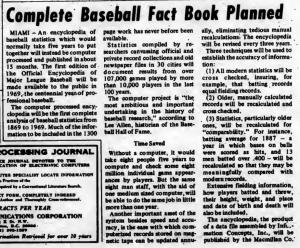May 8, 1968: The Baseball Encyclopedia becomes first book with computer typesetting
An IBM 360 computer processed and typeset 100 years of baseball data into an encyclopedia, marking a milestone in both baseball history and publishing technology.

In September of 1969, Macmillian published The Baseball Encyclopedia, the first encyclopedia to contain complete statistics for every player in the history of professional baseball. The 2337-page landmark encyclopedia exceeded all previous baseball encyclopedias in its accuracy and completeness, becoming an invaluable resource in baseball history. The highly ambitious project was made possible by computers, which were integral in both the processing and typesetting of the data.
A research team led by statistician David Neft spent two years compiling data from 100 years of professional baseball games. The team traveled the nation to track down source materials, from newspaper play-by-play accounts to box scores.
One year prior to the publication of The Baseball Encyclopedia, an article in Computerworld magazine described the plans for the book, stating that the massive amount of data – covering over 100,000 games and 10,000 players – would have required at least five years of manual computing if done without a computer. Instead, the actual processing of the data was completed in just over a year using magnetic tape and an IBM 360 computer. These efforts to automate the calculation and checking of the data subsequently sped up the process of annually updating the statistics, which otherwise would have required significant manual recalculations. The Baseball Encyclopedia also marked a milestone in publishing technology. The book is credited as the first other than phone books to be typeset entirely by computer.
Upon publication, the encyclopedia met a mixed reception, largely due to the fact that the extensive checking of historical data had resulted in changes to the statistics of many star players. Many baseball fans were upset to see their favorite players’ statistics changed. With time, the negative reactions over the revisions faded. The records used in nearly all modern baseball references are considered descendants of the first edition of The Baseball Encyclopedia.
–By Kathleen Esfahany